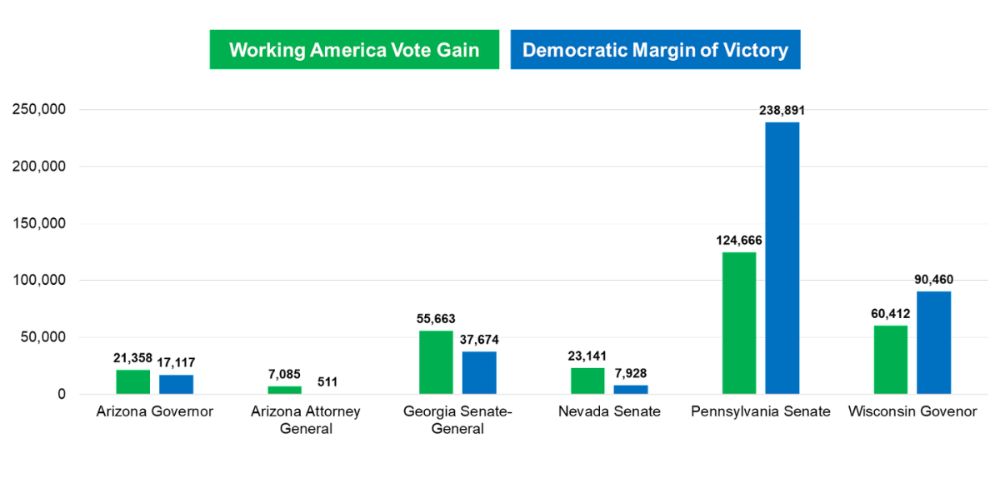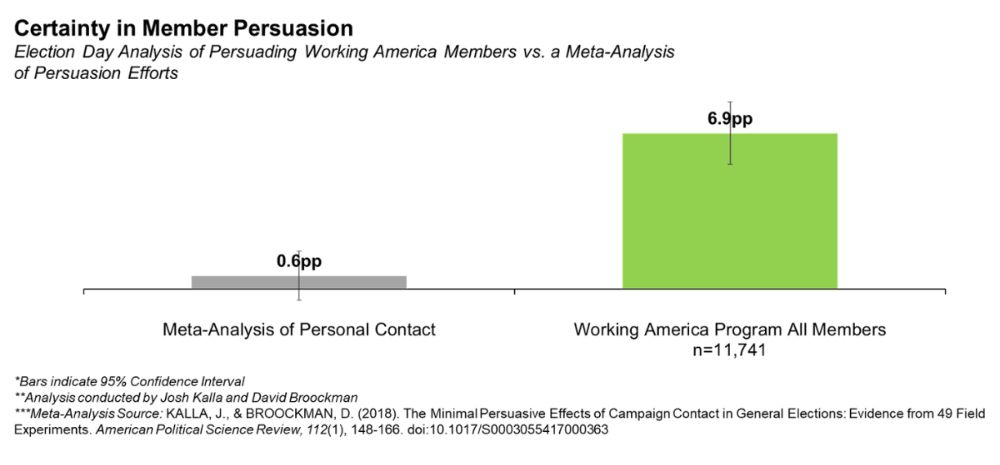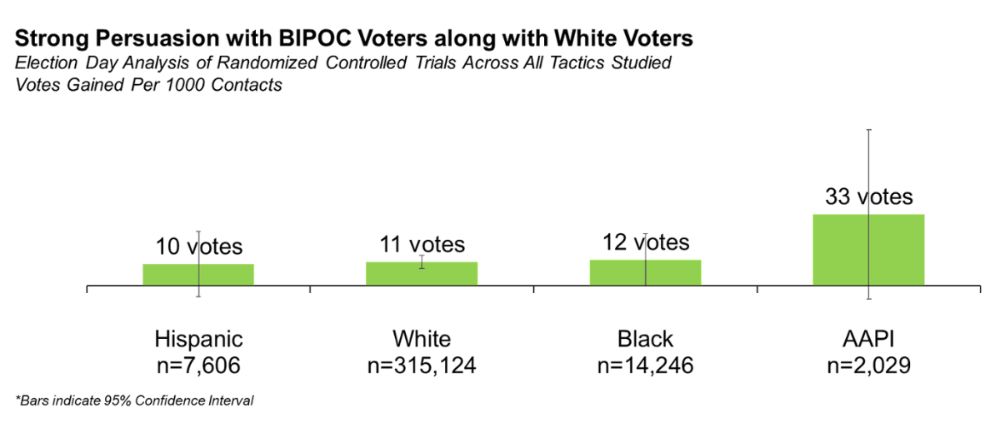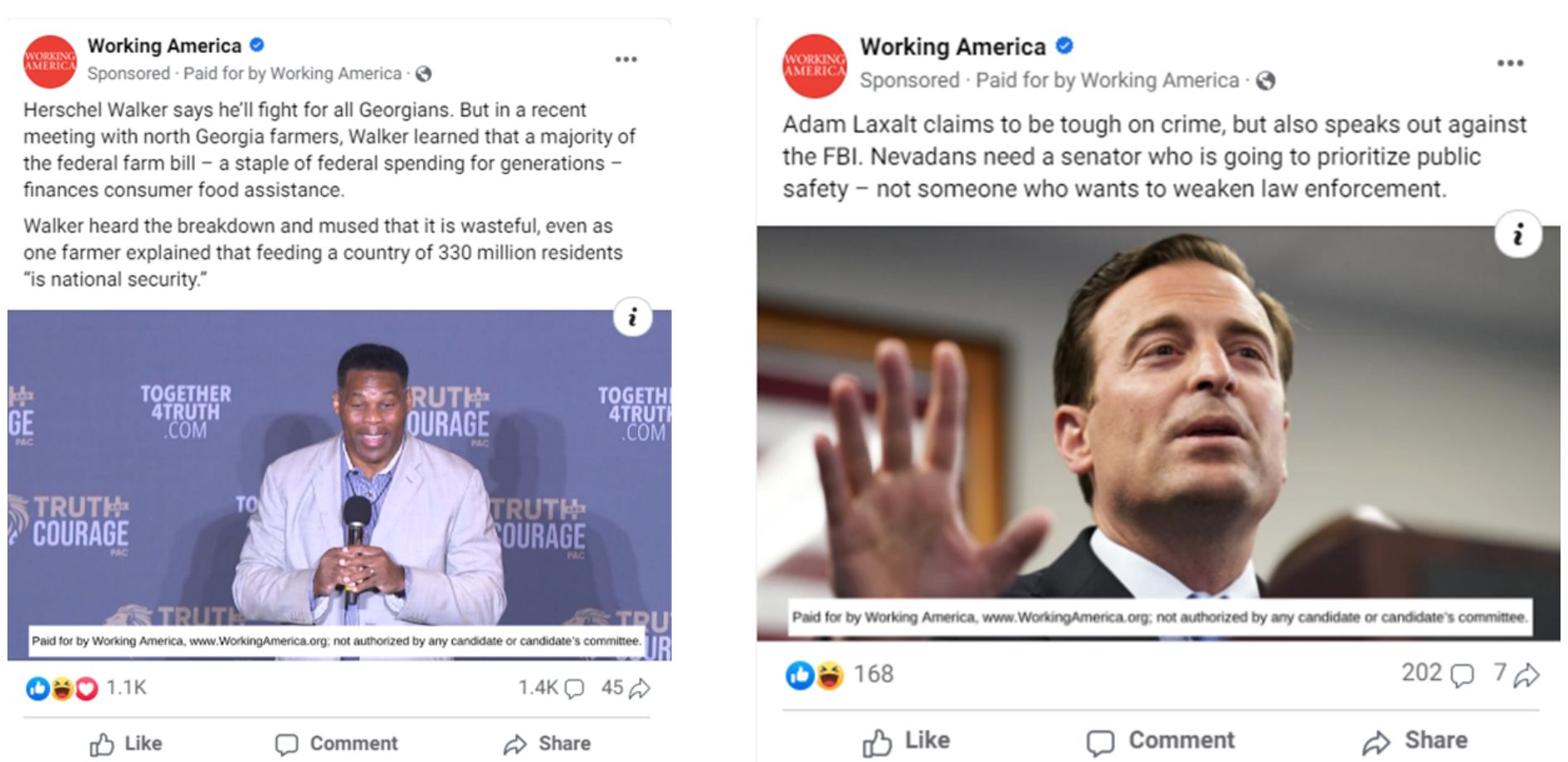Chip in Now to Stand Up for Working People
Working people need a voice more than ever and Working America is making that happen.
Working people need a voice more than ever and Working America is making that happen.
Matt Morrison
08/12/2023
Many are understandably dispirited or angry after last week’s doubleheader of news: the former president was indicted for the third time just as polls showed him holding a commanding lead for the GOP nomination, and in a dead heat with President Joe Biden for the 2024 general election. But that makes it a good time for us to share good news with you. Analysis of our 2022 voter contact program is providing some critical lessons that will ensure Working America can have a meaningful impact in 2024, thanks to your support.
Our 2022 election program generated an additional 407,015 Democratic voters in 102 contests, across 15 states, and allowed us to develop a formula to scale that work even higher in future contests. In critical contests like the Arizona gubernatorial, Georgia Senate and Nevada Senate races, we generated more votes than the margin of victory for the Democratic candidate. In the Pennsylvania Senate and Wisconsin gubernatorial races, the vote gain from our efforts was equal to a substantial share of the Democrat’s margin of victory. The program built on what we had learned from the 2020 presidential campaign, where we generated an estimated 253,684 votes in support of the Biden-Harris victory.

Learn more about the full breadth of the 2022 program and impact here.
Our Science-Based Approach to Organizing
Connecting what’s going on in workers’ day-to-day lives with hard data from the campaign is fundamental to our strategy. For nearly 20 years, Working America organizers in every corner of the country have started every conversation at the door by listening to what is on people’s minds. The everyday needs of working people—safe schools for their kids, affordable housing for their families, access to health care for their loved ones—make up the core of our agenda. Nothing is as powerful as hearing directly from people like Gordon, a 61 year old man from St. Clair Shores, Michigan. Health care was his main worry after seeing the “astronomical cost” to his neighbors from delivering a baby and the more than $30,000 his brother’s family had to pay after a recent procedure. To ensure we’re using the best messages and methods to advocate for that agenda, and to measure our impact at the polls, we use the same method scientists use when evaluating the impact of a new drug on human health: randomized control trials (RCTs).
In an RCT, the group of people receiving the intervention—the medicine in drug trials; and ads, mail, texting or canvassing in our campaigns—is randomly selected and measured against a similar random, statistically balanced group of people not getting the intervention. The difference in their voting behavior then tells us the impact that our interaction has. We use the results of these RCTs to constantly test and adjust our strategy. In 2022, we conducted 225 RCTs before the election to zero in on the best message and targets, and then used that information to contact 29,791,859 people at the door, in their mailboxes or through digital tools. Then we conducted an additional 207 RCTs on Election Day to measure our impact on both change in vote choice and voter turnout. This system is what led to the “votes added” numbers above, and it generated a series of critical lessons that will serve us well going into 2024.
Lessons from the 2022 Campaign
Lesson 1: Membership Moves VotersIt has become increasingly clear that there are advantages on Election Day from our efforts to sign up working-class people as Working America members who will join us in our economic and issue advocacy efforts. Members have always been more responsive compared to non-members, whether we are asking them to turn out to vote for our candidate or answer a text message. In the 2022 election, both the magnitude and certainty of the member advantage on vote gain became clearer.
Magnitude: One way to measure the size of the membership advantage is to compare how often we were able to add votes for our candidate among members versus non-members who received the same number and type of communications.

Source: Meta analysis of Working America Election Day randomized control trials 2020 + 2022
The clear takeaway is that after the one-time investment in signing up a member, the long-term advantage of membership in winning votes is quite large. Certainty: We partnered with well-known political scientists Josh Kalla and David Broockman to study the effect of our member persuasion efforts during 2022 campaigns in Arizona, Georgia and Pennsylvania. They found that our efforts gained 6.9 votes for every 100 contacts, which was orders of magnitude larger than the typical effect. But even more noteworthy was the unusual consistency of the result, with 95% of the outcomes falling within just 1.4 votes in either direction. In other words, our election programs were about as close to a certainty as one can get when trying to win votes at scale in hotly contested battleground state elections.

Lesson 2: Targeting and Message Optimization Works While our member-focused programs generated outsized vote gains, the non-member program was also remarkably effective at generating votes for our preferred candidates. Among non-members, we added 231,845 votes in the battleground states for our preferred candidates. We were able to be so efficient because our RCTs allowed us to continually adjust targets and messages, sometimes in ways we wouldn’t have otherwise expected. For example, conventional wisdom among political operatives is that the best persuasion targets are Independents and people who lack a strong allegiance to either of the major parties, often centered in mostly white, suburban communities. Yet through testing, we see that the most persuadable voters are usually people of color, including those in urban areas, typically seen as GOTV targets for Democrats.

Another interesting insight was gleaned from the response to two of our favorite communications from last year. They used a new (for us) strategy in digital advertising, the “Poison Pill.” These ads were designed to speak to conservative voters and directly challenged our opponents’ perceived strengths by providing new information that undercut them. One went after Nevada GOP Senate candidate Adam Laxalt’s identity as pro-police and the other attacked Georgia GOP Senate candidate Hershel Walker’s identity as a supporter of the agriculture economy. Each ad generated thousands of votes for our candidates, Sens. Catherine Cortez Masto and Raphael Warnock, based on RCT data.

Lesson 3: Long-Term Effects of OrganizingTwo new analyses showed that our organizing is having an impact beyond the immediate cycle. First, we examined canvass conversations our organizers held from 2014 to 2018. We learned that those conversations created a measurable increase in voter turnout in 2022, as much as eight years after the visit. Increasing voter turnout is a vitally important goal for both our electoral efforts and our support for building civic participation beyond voting. We also examined the impact that our 2020 programs had on vote gain in 2022. While most of the 2020 program effects dissipated after the cycle, there was a notable exception. A month-long digital ad campaign in support of then-candidate Biden in October of 2020 had a substantial impact on Democratic vote share in 2022, without any intervening communication. To be clear, that is a bit of an unusual finding that we want to replicate before banking on it, but it is apparent that the things we do today are showing up well beyond the timeline we anticipated.
Lesson 4: New Insights Can Power New Strategies When we ask new questions of the data, we find new knowledge. For example, while we have principally focused our work on adding votes for our candidates through persuasion and voter turnout, we now see a consistent pattern that the same communication is causing Republicans to not vote, a politically beneficial, but unintended consequence of our outreach. For example, our non-partisan mail and text message campaigns that were focused on raising the importance of progressive economic concerns resulted in reduced voter turnout among people who typically vote Republican. We see this trend in both 2020 and 2022 data across multiple states. We saw the opposite response to our 2022 Poison Pill digital ads, which were designed to target Republicans but also wound up galvanizing Democrats to turnout to vote. This is a lesson we are eager to replicate.
The Road Ahead
As stark as our political landscape appears, the data shows that our tools can reliably add hundreds of thousands of votes in battlegrounds and can scale even higher. Stay tuned for more lessons from the field and thanks as always for helping make this work possible.
Regards,
Matt Morrison
P.S.: This October, Working America turns 20 years old! We will have more to say as the date draws near about the first 20 years and the next 20 years.
We use cookies and other tracking technologies on our website. Examples of uses are to enable to improve your browsing experience on our website and show you content that is relevant to you.